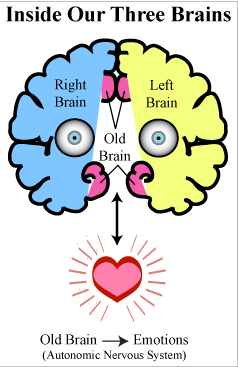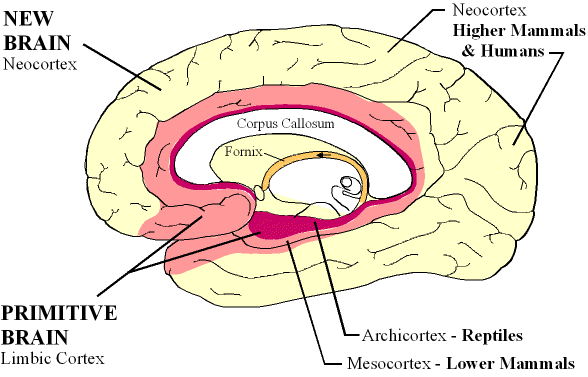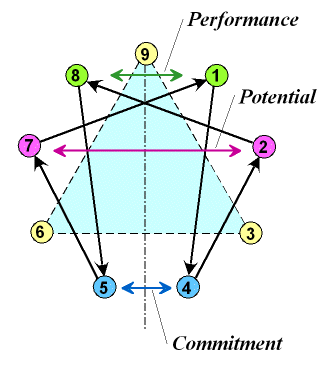Back • Return Home
Inside Our Three Brains
Abstract
We have three brains which work independently of one another and yet seek a creative balance together. Thus, there are three dimensions to human experience. Our right-brain is intuitive and holistic. It intuitively seeks out integrated patterns of meaning as a framework of understanding that we implicitly relate to. Our left brain is social. It uses language to formulate a commitment to behavior consistent with intuitive frameworks that we may entertain. Our old brain is anchored to our evolutionary history. It too is Janus faced. It emotionally fuels our thoughts and behavior on the one hand and it assesses our performance on the other. Our thoughts and behavior intuitively seek an emotional balance between the two faces.
Key Words: Cosmic Order, System 4, three brains, right brain, left brain, old brain, human experience.
Introduction
Three Brains: Yes we have three brains. They work independently of one another and yet they seek a creative balance together. (This theme was first introduced in Fisherman's Guide.)
One Old Brain: One of our brains is very old. It began to evolve when the amphibians crawled onto land to give rise to the reptilian age. It is over 400 million years old and yet it remains structured into the anatomy of our human brain. It includes also the brains of the lower mammals, such as the horse and the cow.
Two New Brains: Two of our brains are newer. They are the two hemispheres of the neocortex. They bloomed with the higher mammals, with dogs, seals, whales, elephants, and primates. They reached their zenith with humans.
Language: It was language that gave the two hemispheres of the human brain separate jobs. Language allows us to substitute words for elements of experience. We can deal with things that have happened through language. We can make sense of the past and learn from it. We can also make plans for the future. We can span space and time. We can integrate our history.
Right & Left Brains: But this left brain ability to think and speak in words brought with it a right brain sense of wonder about how things work. We had to develop a right-brain intuition about how experience is ordered so we could provide for our needs. We also became acutely aware of death.
Cosmic Order: So our right brain intuition began to seek out the cosmic order. Language made us seek to understand how everything works. We must integrate our history, the whole of history. We need a framework of understanding to invest life with meaning. And creation myths won't do in a global society. We need direct intuitive insight into how the cosmic order works.
Three Dimensions: So there are three dimensions to human experience. Our right-brain is intuitive and holistic. It seeks out integrated meaning and potential. Our left brain is social. It uses language to formulate a commitment to behavior. Our old brain is anchored to our evolutionary history. It emotionally assesses our performance.
• The right and left brains are connected by the corpus callosum.
• In the 1960's, this huge interconnecting nerve bundle was surgically cut to relieve severe epileptic seizures in a number of patients. The surgery helped to restore normal function.
• Tests on these people by Roger Sperry proved conclusively that our right and left brains do in fact work independently.
• The right brain is generally holistic, mute, and intuitive. It seeks insight into integrating themes to generate creative ideas. It implicitly accesses insight through a sense of wonder.
• Only the left brain can speak and it deals extensively in language, logic and reason. It works out explicit techniques of behavior and it commits the body to act.
• The right brain designs a house. The left brain builds it.
• The new brains are fueled by the old brain. It supplies the energy to and from the autonomic nervous system to wonder, think, and act. We respond to felt needs and judge our performance by emotional balance. The old brain is called the Limbic System.
• It has long been scientifically accepted that the old and new brains work separately. Thought and feeling often don't get along.
The Old and New Brains
• The cerebral hemispheres of the brain have been compared to a TV screen which can reflect emotional experience in conscious awareness and respond accordingly. The cerebral hemispheres and the autonomic nervous system evolved together in concert.
• Humans are vertebrate animals. The human brain evolved from the reptilian and mamalian brains in three distinct steps associated with the reptiles, lower mammals, and higher mammals.
• The first amphibians that crawled onto land had three cerebral brain bulges but they were all undeveloped. Each bulge bloomed with the themes of three successive evolutionary epochs.
• During the reptilian epoch, the first brain bulge blossomed while the other two didn't. Reptiles can reflect emotional experience in conscious awareness but they can't modulate or alter their responses. A crocodile has a very limited emotional repertoire.
• But during the very long reptilian age, that ended with the collapse of the dinosaurs, a great many species explored a vast range of stereotyped behaviors and their emotional patterns.
• The first mammals diverged from the reptiles about 160 million years before the demise of the dinosaurs, but they remained small rodent-like creatures that didn't diversify.
• The lower mammals began to diversify just before the end of the reptilian period, and this marked an expansive development of the second bulge in the cerebral brain, with a limited growth of the third bulge. The second brain bulge outpaced the reptilian bulge and it had a small degree of independence from it. It also outpaced the modest expansion of the third brain bulge.
• The first two bulges nevertheless formed a functionally integrated cerebral brain that is directly connected to the autonomic nervous system. The connection is largely through the nerve bundle called the fornix as shown. The fornix transmits from the old brain via a brain structure called the hypothalamus to both divisions of the autonomic nervous system.
• The lower mammals thus became invested with a greater ability to consciously reflect on their emotional input and modulate and alter their emotional responses. A horse is more emotionally responsive than a crocodile. It can learn, be trained, and develop some empathy with humans.
• With the higher mammals, with the cat, dog, dolphin, monkey, ape and so on, came an explosive growth of the third brain bulge. This provided a much enhanced ability to reflect on emotional input and develop a varied repertoire of responses. A dog is much more agile and responsive than a horse. They can develop very strong bonds with humans and learn to understand a significant vocabulary.
• With humans, the hemispheres of the third bulge, or new brain, expanded to enfold the first two bulges inward around the top of the brain stem.
• The first two bulges form the limbus or edge of the cerebral cortex and so are called the Limbic Cortex. Together with other old structures in the brain they make up the old brain (Limbic System).
• So, humans remain emotionally anchored to our vertebrate animal ancestry that is hard wired into our brains. We can draw on an immense range of emotional patterns spanning 400 million years of evolutionary history. And we strive to integrate that history and bring it to emotional balance with our social commitments in everything that we do.
• A fourth major step in our evolution was the development of language. This delegated separate jobs to our right and left cerebral hemispheres. As this step developed we became human with greatly enhanced creative powers. No creature on earth can match our creative abilities. We have assumed responsibility for the planet and we also remain anchored to our natural history.
The Six Domains of Thought and Feeling
• There are six domains of thought that work in polar pairs to provide insight into the three dimensions of experience associated with our three brains.
• Insight into our potential dimension is provided by a mute polar relationship between intuitive idea development and our available resources of integrating themes accessed through wonder.
• Integrating themes are archetypal memory patterns that are accessible from a master sensorium of all experience. Access to them varies according to our individual talents and learned capabilities.
• We may conceive of the germ of the greatest idea in the world, but if we don't have personal access to the resource capacity to develop it, then it will remain the sterile germ of an idea.
• Conversely, we may have been blessed with great natural talents and capabilities and yet not develop ideas to translate this into creative potential. This polar relationship between idea creation and resource capacity provides insight into our personal potential dimension.
• Insight into our commitment dimension is provided by the polar relationship of the logic of language and reason to organized input from our social environment. Language is a social tool and it has evolved with our cultural traditions.
• We use language to formulate and express our behavior according to acceptable standards of social organization. This polar relationship between language applied to behavior and our organized social context is what provides insight into our commitment dimension.
• Insight into our performance dimension is provided by the polar relationship between our emotional feelings of need and emotional feedback from our expressed responses to need.
• Since our emotional feelings of need are anchored to our whole evolutionary history, they can be very deeply felt. They can also relate to a timeless sense of the cosmic order from our felt need to integrate our experience and make sense of it. These feelings can provide long-term guidance.
• So, emotional feedback from our immediate commitments to behavior are seen in polar relationship to our historic integration of feelings according to how we live our lives. This provides us with polar insight into our performance dimension. We feel the value of our actions.
• The two divisions of the autonomic nervous system work in mirrored reflection to the cerebral hemispheres, with the old brain acting as the mirroring pivot or axis between thought and feeling.
• The sympathetic division fuels the patterned energies for immediate thought and action. It works in accord with the left brain. It's energies are archetypal and are patterned for short term needs.
• The parasympathetic division provides patterned restraint to the sympathetic division and it works in accord with the right brain. It's archetypal energies are patterned for long term interests.
• For example, energetic feelings of running a sprint must be restrained when running a marathon. An archetypal plan is needed for a marathon that paces the sympathetic expenditure of energies.
• Meditation techniques employ reflection across the axis of our old brain. They generally focus on stilling left brain thought and related sympathetic emotions to facilitate the arousal of more timeless parasympathetic archetypal energies concerned with spanning space and time and integrating history. A common technique is to count the breaths to 5 or 10 and keep repeating this to stop the mental verbiage that often captures our thoughts on a meaningless treadmill. The breath is an autonomic process that we are consciously aware. Still the discursive intellect can arouse more meaningful parasympathetic intuitive patterns of experience.
• These ideas are more thoroughly developed in Fisherman's Guide to the Cosmic Order.
The Enneagram and The Brain
The six pointed sequence of System 4 (the enneagram) generates the six particular domains of thought and feeling. They provide structural insight in polar pairs as shown. The universal terms regulate and integrate them.
Term 1 is emotional perception of need.
Term 8 is balanced response and balancing energy supply with demand.
Term 2 is creation of idea.
Term 7 is resource capacity to develop idea.
Term 4 is organized context and sensory input.
Term 5 is thought and behavioral action.
Term 9 is integrated universal discretion.
Term 3 is transference of idea to a form of behavior.
Term 6 is the corporeal body, our flesh and blood.
For how the enneagram actually works refer to System 4 and System 4 Terms. The sequence of term trans-formations can be traced synapse by synapse through the structure of the nervous system. This is developed in Fisherman's Guide and more rigorously in Science & Cosmic Order. The three polar dimensions also apply to structuring any business for optimum results. This is fully developed in Enlightened Management. A summary is presented in the article Structuring Your Organization.
Transcending the Creative Process
The System of delineating how the cosmic order works provides an accurate insight into the evolutionary process and how we evolved three brains through four levels of vertebrate evolution. The structure of our brain anatomy and its neurophysiology itself confirms the accuracy of the System in showing how the cosmic order works. However, insight into the cosmic order as a universally intelligent process integrating history must itself transcend the whole of history. It must transcend the whole of space and time. In understanding this it allows us to bring our creative endeavors into a sustainable balance with the evolutionary process. Our right-brain insight into the cosmic order can find left-brain social expression in an emotionally balanced manner via our old brain that is consistent with our own evolution. The three brains can work in harmony with the cosmic process by which we have evolved. In this way we can learn to make our social commitments in balanced ways that need never die. Our creative endeavors can find timeless or eternal value. The ultimate reality is universal values - truth, justice, compassion, love, unity - and these are not things of the flesh. Various aspects of this theme run through all of the material presented in these articles and books.
Note: The approach used here is different in kind to the nine personality types of the enneagram that have gained popularity in recent years. The cosmic order structurally embraces all possible varieties of experience. It is not restricted to a limited number of archetypal behavioral patterns. These may evolve as they will. For example the three polar dimensions of experience must apply to any socially developed intelligent life form anywhere in the universe. Any intelligence must have some degree of insight into the cosmic order and how things work, however meager, in order to function at all. This compares to right brain insight and it must be generated from some sort of memory of past events. Recall of that memory must emote energy patterns. This compares to the way our old brain works. These recalled patterns must be tailored to make relevant connections to ongoing circumstance in a way that permits anticipated future results. There must be a spanning of space and time. And in any socially developed species with a high degree of collective creative potential there must be some form of communication between individuals synonymous with left brain language. So the three dimensions must always be in evidence. Personality types relate to stereotypical behavior and not to universal structural realities of the cosmic order. All of us have our strengths and weaknesses and we need ways of using the former to redeem the latter. The point here is that this structural approach to the cosmic order presented here can add new dimensions to self improvement that can facilitate other more behaviorally oriented approaches.




